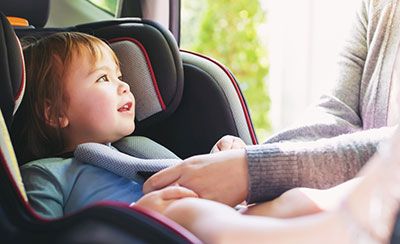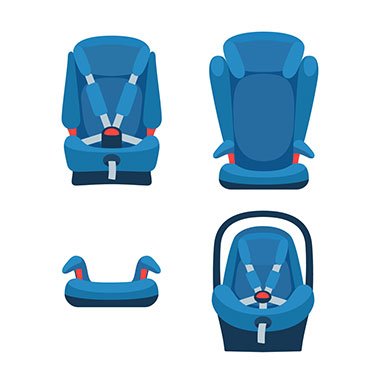As a parent, one of your top priorities is your child's safety at all times. However, while you aim to remain vigilant in keeping them safe, some common car seat mistakes can lead to increased risk and potential injury if not avoided.
Armed with the correct information, you can avoid these mistakes and keep your little one out of harm's way while they're on the go! In this blog post, we'll explore 9 common car seat errors parents tend to make that you must avoid to ensure optimum safety for your children.
More...
Take Away Key Points:
Table of Contents
- Can you err with car seats? All you need to know
- 1. The car seat is too loose
- 2. The chest clip is either too high or too low
- 3. Moving from a rear-facing seat to a forward-facing car seat too soon
- 4. Wearing puffy coats
- 5. Adding extra accessories
- 6. Asking for help at the wrong places
- 7. Not knowing or ignoring the expiration date
- 8. Applying seat belt protectors
- 9. Not adjusting harness straps
- FAQs
- Final Words
Can you err with car seats? All you need to know
Car seat safety standard is a top priority for all parents when their little ones use their child car seats. But, there are certain mistakes multiple parents always make.
So, let's examine them and learn how to maximize car seat safety while on the road.
1. The car seat is too loose
Incorrectly installed car seats are the most common mistake many parents make. For example, the car seat might not be attached to the vehicle, or the car seat is not installed correctly.
To ensure the car is installed correctly, perform a small pinch test. For example, use the non-dominant hand, check the belt path, and shake the seat a bit. The test will ensure secure installation, so you will avoid a loose seat.
If it moves less than one inch in the back seat of your vehicle, the child's car safety will be optimal. If it moves more than one inch, you must install the car seat again in the back seat, but this time correctly.
In addition, install your seat in the middle seat, if possible, to ensure the best recline angle and keep your little one safe. If the middle place is occupied, you can install the seat near the windows.
Also, do not forget the top tether strap for proper car seat installation. The top tether is necessary for all forward-facing models - convertible seat or booster seat. It eliminates serious injury to the child's head and collarbone if the child's car seat comes forward in a car crash.

2. The chest clip is either too high or too low
Car seat safety is important to keep children safe while on the road. Parents must take the time to make sure their child's car seat is installed correctly and that all straps are adjusted properly.
Mistakes can be made quickly, so it is important to double-check everything before taking off. For example, incorrectly positioned harness straps will easily jeopardize your child's car safety. As a result, the kid might slip away in a car accident and end up fatally.
Ensure the chest clip is positioned at the top of your child's armpits. Thus, the shoulder harness straps will stay on the top of your child's shoulder. In addition, the crotch buckle is closest to your child's body, but not underneath your children, so as not to create discomfort and pressure.
The proper position of the crotch buckle and chest clip will keep the straps tight, and the shoulder harnesses covering the child's shoulder to avoid slipping away and falling off the car seat. The child's head will not touch the child's collarbone, as it might happen when the harness straps (or seat belts) are too loose, or the children are not ready for them.
3. Moving from a rear-facing seat to a forward-facing car seat too soon
According to the AAP, children must remain in the rear-facing car seat once they reach the maximum weight and height limit determined by the car seat manufacturer.
However, the AAP also suggests parents should keep children in the rear-facing seat as long as possible if the harness straps fit snugly and increase car seat safety standards. For this reason, various car seat manufacturers come with the most convertible car seats with additional support for children up to 50 pounds to ride rear-facing as long as possible.
Once your child outgrows the rear-facing position, they can move to the forward-facing seat. The children should stay in the forward-facing seats until they can move to the booster seats. This occurs when the children are around five years old and have over 65 pounds, so they cannot ride in the forward-facing position.
The conclusion is that you must not rush your child and move your rear-facing baby from rear-facing seats to forward-facing seats and later the booster seat too soon. Instead, read the car seat's manual for the upper weight and height limit, and check if the child rear-facing can stay in the rear-facing position following the AAP standards.
In addition, once your little one is ready (between eight and twelve years old), they can use the regular seat belt after a booster seat. To use the seat belt, they should be between nine and twelve years old (keeping them in the booster seat is better for car seat safety).
The seat belt must support the kiddo properly - the shoulder belt must cover the chest and shoulder, while the lap belt must cover the upper thighs and hips. In addition, the children must touch the floor with their feet. Otherwise, they cannot use the regular seat belt. So, follow the manufacturer's instructions and NHTSA standards not to endanger your child's life.
4. Wearing puffy coats
Do not allow your little ones to wear puffy coats and similar clothes in the rear or forward-facing car seats. Such clothes will create extra space between harness straps and the child's body so that you will endanger your little ones.
The solution is to place your child into the car seat without puffy clothes and then cover them with the blanket afterward to keep them warm.
5. Adding extra accessories
Many parents reach out with questions about using aftermarket products such as harness pads, head supports, and extra padding with the car seats they have. These items may be readily available for purchase at stores and appear safe, leading people to ask why companies are allowed to sell them if they are dangerous.
Unfortunately, these add-ons have not been tested with the specific car seat you purchased, so there is no way of knowing how safely they will function in a crash. In addition, using any product not included with your original car seat purchase can change its performance in a collision.
It would be best to use only products coming in the original packaging of the car seat. Most seats include head supports, harness covers, and inserts with the car seat.

6. Asking for help at the wrong places
Although it's a common belief that you can have your car seat checked at the children's hospital, fire station, or police department, no one guarantees the doctors and nurses will know about car seat installation, proper harness height, or right angle of the buckles. It's not part of their medical education. The same applies to police officers and firefighters.
It would be best to check with your certified child passenger safety technician and look for institutions and organizations offering various certified passenger safety technicians. They are the most competitive licensed experts to help you with all car seat issues parents might encounter. You can find a CPST here.
7. Not knowing or ignoring the expiration date
The expiration date is crucial for two reasons:
- Possible breakage of the plastic shell and frame and other car seat safety parts in the car accident.
- Updated safety performance regulations determined on the car seat labels.
All car seats available for use are crash-tested for maximum safety; however, the car seat manual determines you must replace the car seat immediately if it's in a crash or after the expiration. Many seats are designed to last between six and ten years, so do not use them after they expire. They will not protect your child in the best way.
The best solution is to check the manual and set a reminder on a calendar to ensure you will follow the safety standards and avoid endangering your little one's life.
8. Applying seat belt protectors
Understandably, car seats must be tightened to provide the best protection, leading to indentations on your vehicle's seat. In addition, children often cause messes that are hard to clean up, particularly in the tight spaces between the car seat and the vehicle seat. It may be tempting to purchase a seat protector. However, this can provide a false sense of security, allowing for more movement than is safe during a collision.
It's best to check the manufacturer's instructions, as some seats offer a thin sheet or towel between the vehicle seat and car seat, while others don't.
9. Not adjusting harness straps
You must ensure the proper position of the harness and shoulder straps while kids are growing. Improper placement of harness straps will cause injuries in crash forces.
So, for rear-facing children, the harness height should be at or slightly below the child's shoulders. The shoulder straps will not be uncomfortable for little ones.
For forward-facing kids, the harness height should be at or slightly above the child's shoulders to avoid the pressure of the shoulder straps.
FAQs
What is the most common problem involving car seats?
The most common problem involves incorrect installation, lack of harness adjustments, and misusing seat belts.
Are booster seats supposed to be loose?
No, the seats should be tight to the vehicle seat. You must perform a test and shake the seat to see if it moves less than an inch in all directions. If it does, you're good to go.
How to avoid infant car seat installation mistakes?
To avoid infant car seat mistakes, ask your verified CPST or check the instruction manual. Or watch videos to help you and get your seat inspected at inspection centers.
What percentage of car seats are installed incorrectly?
More than 59% of car seats are installed incorrectly, according to the NHTSA.
What are common mistakes when buying a used car seat?
The most common errors include the following:
- Not doing the research before buying a used car seat - to check its history and see if it was involved in car accidents
- Not buying a suitable car seat
- Inheriting a used seat from a friend
- Not thinking ahead to include all possible complications of the seat
- Forgetting the expiration date or registering the seat
Final Words
As you can see, parents might not be aware of multiple common car seat mistakes, jeopardizing their children's safety on the road.
Therefore, it would be best to refer to the expert's and manufacturers' recommendations to ensure your little ones are safe and sound on the road. Otherwise, they might suffer from severe injuries or even death in car collisions.
And ensure you read our guide thoroughly to avoid the most common errors.
